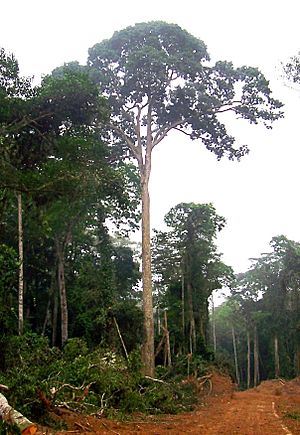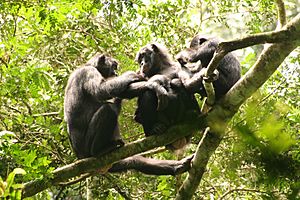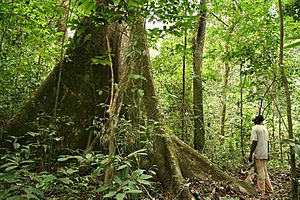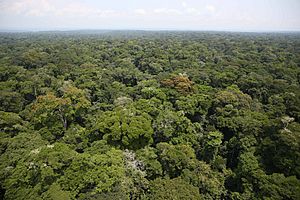Congolian rainforests facts for kids
Quick facts for kids Congolian rainforests |
|
|---|---|
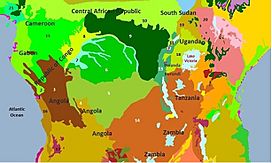
Congolian rainforest ecoregions: 2. Atlantic Equatorial coastal forests, 6. Central Congolian lowland forests 7. Eastern Congolian swamp forests, 8. Western Congolian swamp forests, 9. Northeastern Congolian forests, 15. Northwestern Congolian lowland forests
|
|
| Ecology | |
| Realm | Afrotropical |
| Biome | Tropical and subtropical moist broadleaf forests |
| Geography | |
| Countries | |
The Congolian rainforests are a broad belt of lowland tropical moist broadleaf forests which extend across the basin of the Congo River and its tributaries in Central Africa. They are the only major rainforests which absorb more carbon than they emit.
Description
The Congolian rainforest is the world's second-largest tropical forest, after the Amazon rainforest. It covers over 500,000,000 acres (2,000,000 km2) across six countries and contains a quarter of the world's remaining tropical forest. The Congolian forests cover southeastern Cameroon, Gabon, Republic of the Congo, the northern and central Democratic Republic of the Congo, and portions of southern and central Africa.
To the north, south, and southwest, the forests transition to drier forest-savanna mosaic, a mosaic of drier forests, savannas, and grasslands. To the west, the Congolian forests transition to the coastal Lower Guinean forests, which extend from southwestern Cameroon into southern Nigeria and Benin; these forest zones share many similarities and are sometimes known as the Lower Guinean-Congolian forests. To the east, the lowland Congolian forests transition to the highland Albertine Rift montane forests, which cover the mountains lining the Albertine Rift, a branch of the East African Rift system.
Ecoregions
The World Wide Fund for Nature divides the Congolian forests into six distinct ecoregions:
- Atlantic Equatorial coastal forests (Cameroon, Equatorial Guinea, Gabon, Republic of the Congo, Angola, Democratic Republic of the Congo)
- Northwestern Congolian lowland forests (Cameroon, Central African Republic, Gabon, Republic of Congo)
- Western Congolian swamp forests (Republic of the Congo, Democratic Republic of the Congo)
- Eastern Congolian swamp forests (Democratic Republic of the Congo)
- Central Congolian lowland forests (Democratic Republic of the Congo)
- Northeastern Congolian lowland forests (Democratic Republic of the Congo, Central African Republic)
Flora and fauna
The Congolian rainforests are home to over 10,000 species of plants, of which 30% are endemic. The Congolian rainforests are less biodiverse than the Amazon and Southeast Asian rainforests. However, its plant and animal life is still more rich and varied than most other places on Earth. The Congolian Forests are a global 200 ecoregion.
There are over 400 species of mammals in the rainforest, including African forest elephants, African bush elephants, chimpanzees, bonobos, mountain gorillas, and lowland gorillas. The okapi is endemic to the northeastern Congolian rainforests.
The rainforests have 1,000 native species of birds, and 700 species of fish.
Conservation
Threats to the rainforests include destruction and fragmentation of forests by commercial logging, oil palm plantations, and mining. The bushmeat trade and poaching is depleting the rainforests of wildlife. With annual forest loss of 0.3% during the 2000s, the region has the lowest deforestation rate of any major tropical forest zone.
See also
 In Spanish: Selva del Congo para niños
In Spanish: Selva del Congo para niños


